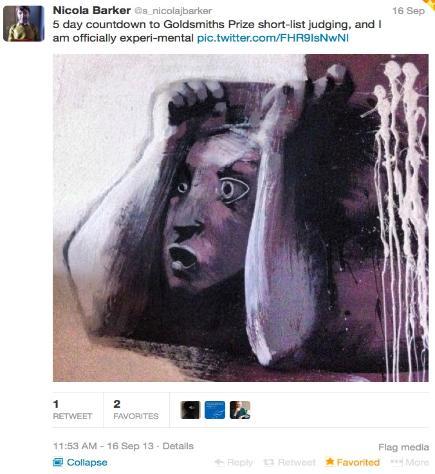Chair of Judges' Speech 2013
Before I get to the real business of this evening, bear with me for a couple of minutes while I thank just some of the key people who have made the prize possible. First on that list is the Warden, Pat Loughrey, who has been whole-heartedly committed from the outset both to the prize and the idea of a Goldsmiths Writers’ Centre. Thanks to Adam Thirlwell, who made possible the happy association with the New Statesman by introducing me to its then culture editor, Jonathan Derbyshire. Thanks too to Claire Shanahan of the Booktrust for teaching us how to run a prize. I have been lucky to work with two splendid prize administrators: Wendy Jones and Kerstin Feurle. Thanks to them and to my colleagues, Maura Dooley, Blake Morrison and Francis Spufford for their early and ongoing support for the whole project.
Finally, it is a particular pleasure to express gratitude to my fellow judges, Nicola Barker, Jonathan Derbyshire and Gabriel Josipovici both for their willingness to put their names to what was a prize without a profile, and for their critically rigorous and spirited contributions to the judging process.
One of the joys of working with Nicola has been to follow her reflections on this process on Twitter:
Here is a key moment in the history of Nicola’s reading, featuring one of her two dogs, Moses:

Here is a reflection on our shortlist meeting, featuring her second dog, Sarge, (with a glimpse of Moses in the background, perhaps representing an anxious chair of judges):

Here is Nicola torn between conflicting demands:

And here is a moment of exasperation some days before our shortlist meeting:

As it happens, we decided not to use the term ‘experimental’ in describing the brief of the Goldsmiths Prize, but chose instead to stress the quality of originality expressed in the very name of the most popular of literary kinds: the novel. To call a work of fiction ‘experimental’ is to imply that it somehow deviates from the genre’s natural concerns, structures and idioms. Yet a long view of the novel’s history – one which takes in the rich period before certain conventions calcified in the nineteenth century – suggests that the novel is most itself when writers make use of its near endless resources and possibilities and are prepared to challenge and surprise their readers. This has nothing to do with form for form’s sake. As should be clear from the books on our shortlist, form is not the enemy of content but rather its closest ally. Nor should it be confused with the tarnished notion of ‘innovation’ associated with glib marketing. Overused conventions quickly become clichés, so that they lose the power to speak, and to make it new is to offer a powerful antidote to the numbing effects of habitual perception.
Now to the heart of the matter: the six boldly original and defiantly idiosyncratic books that we are here to celebrate. I will discuss them in alphabetical order by author.
First, Jim Crace’s beautifully written novel, Harvest. Less obviously convention-defying, perhaps, than some of the books on our list, its subversiveness is to be found in its uncertain generic status, and its refusal to offer the reader unambiguous closure. A historical novel without precise historical referents and a fable whose secondary meanings have a will-o’-the-wisp quality, Harvest is a haunting and unsettling book because of Crace’s willingness to set the logic of one narrative thread against another. While one strand of the narrative seems to explain the expulsion from Eden in socio-political terms, other strands complicate and undermine it by hinting that paradise was always already troubled by human imperfection.
Lars Iyer’s Exodus shows us what it is to write a novel after the death of Literature with a capital L. Its serio-comic energy is fuelled by something like the paradox encapsulated in the famous concluding sentences of Beckett’s Unnamable: ‘I can’t go on. I’ll go on.’ Iyer and his characters can’t go on because the dreams that animated the masterpieces of Western culture are dead, but they do go on because the values that are threatened by philistinism require passionate defence. Eschewing the dogmatism and confidence implicit in closed novelistic forms, Exodus makes clever use of narrative voice and a virtue of episodic structure.
Eimear McBride’s A Girl is a Half-formed Thing is not an easy read. It is nearly always disturbing and frequently upsetting. It is also utterly compelling as it maintains a seldom-encountered level of emotional intensity throughout its 200 pages. If ever a novel gave the lie to the notion that formal inventiveness necessarily precludes feeling, it is this one. In a perfect marriage of form and content, McBride has created an idiolect, dominated by sentence fragments, which enacts the narrator’s pained and traumatised responses to a hostile world with remarkable power and clarity. It is a masterpiece of sustained poetic prose.
David Peace’s Red or Dead begins with three words that resonate throughout the novel: ‘Repetition. Repetition. Repetition.’ To say that it is a novel about football is to give no sense of its extraordinary qualities. Somewhere behind the book, lies the hackneyed idea of football as metaphor for life, but Peace makes us see it anew by showing how repetition and routine underpin thrilling sporting encounters as much as they do the banal acts of daily life. A Waiting for Godot in two halves rather than two acts, its handling of both the pathos and the absurdity of the human condition is incredibly moving.
Ali Smith’s Artful is typical of the work of a writer who is always restless with the constraints of form. That her publishers have marketed the book as both a work of fiction and non-fiction is testament to its wonderfully fertile amphibiousness. Just as the early novel drew eclectically on non-literary forms to create something new, so Smith novelizes the essay and the lecture to create a work so distinct that we can only call it Artful. Shunning the authoritative voice of the ‘lecturer’, Smith interweaves fiction and essay, thereby rendering the lecture’s traditionally authoritative pronouncements contingent. Artful brilliantly orchestrates a dialogue between competing discourses as only the novel can.
Philip Terry’s tapestry similarly achieves a complexity of vision by bringing together seemingly incompatible elements. Focusing on the marginal images in the Bayeux Tapestry, it is, in part, a reconstruction of those stories that ‘History’ has traditionally ignored or suppressed. Hence we are given an account of the Norman Conquest from the point of view of the tapestry’s English embroiderers. But Terry knows that the ‘unheard melodies’ of the 11th century can now only be accessed through the imagination, so tapestry is also a self-conscious and playful work with a keen awareness of the limitations of both history and fiction. Nowhere is this better seen than in the novel’s invention of an ‘Old English’ which is by turns authentic and inauthentic and a narrative idiom that combines realism with magical realism.
That the selection of a winner from a shortlist is both difficult and to some extent undesirable is one of the clichés of the prize-awarding process, but it is no less true for that fact. These are all wonderful books with their own distinctive merits. One extraordinary novel, however, stands out in this shining company. The winner of the Goldsmiths Prize 2013 is A Girl is a Half-formed Thing by Eimear McBride.
Tim Parnell